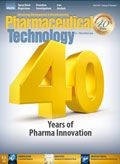Perspective: From Art to Science
Russell Madsen, president, The Williamsburg Group, and member of the Pharmaceutical Technology editorial advisory board, shares his thoughts on technology innovations and regulatory implications.
Russell Madsen

Russell Madsen, president, The Williamsburg Group, and member of the Pharmaceutical Technology editorial advisory board, shares his thoughts on technology innovations and regulatory implications.
PharmTech: During your more than 50 years in the pharmaceutical industry, how has the industry evolved? What advances have been made? What were some factors that hindered advances?
Madsen: Computers and information technology have transformed the industry. In 1965, computers and data processing were used primarily for financial purposes and top-level management information systems. There were no PCs, and the Internet had not been invented. Records and forms were produced using typewriters and were photocopied to be filled in by hand. Transmission of records was by mail, or fax if more rapid movement was necessary.
The use of paper records hampered drug development because it was not easy to evaluate the masses of data resulting from formulation, stability, safety, and clinical studies to optimize manufacturing processes and to ensure the final commercial formulation was the same as the one(s) used for clinical trials. Multivariate analysis was a dream.
The company I worked for in 1965 was much more integrated than those of today. On a single campus, we conducted R&D, synthesized many of our APIs, manufactured oral and sterile finished products, produced rubber stoppers, printed labels, and manufactured unit cartons.
Manufacturing has moved from art to science. The dryness of granulations used to be literally determined by operator ‘feel’, and sugar-coated tablets were coated and polished by skilled operators who knew when the finished tablets were ‘good’ by sight. Now, these operations are automated and scientifically controlled.
Chemical analysis was done using titration and spectrophotometry. Gas chromatography was just coming into general use in 1965 and high-performance liquid chromatography, now a mainstay of pharmaceutical analysis, didn’t take hold until the mid-1970s. Laboratory information management systems (LIMS) were in their infancy until the mid-1990s.
Innovations foster control
PharmTech: What are the top three innovations that have changed the industry the most over the past 40 years and why?
Madsen: In my opinion the top three innovations are: Information technology/PC networks/Internet, advanced aseptic processing technologies, high performance liquid chromatography (HPLC)/genetic and mapping/protein mapping.
These innovations have resulted in more and better control of pharmaceutical development, approval, manufacturing, distribution, and patient safety than had been available prior to their implementation, allowing elucidation of drug and biopharmaceutical structure and comparison of generics and biosimilars to innovator products.
Regulations help-and hinder-advances
PharmTech: How have regulations and standards advanced or hindered advances?
Madsen: A case can be made for both scenarios. Regulations and standards have clarified regulatory expectations and have resulted in improved drug quality and consistency. On the other hand, regulatory expectations have tended to hinder advances in emerging technologies such as restricted access barrier systems (RABS), isolators, and closed-vial filling systems, either through lack of understanding or implementation of stringent sterilization and environmental monitoring programs that may not be suited to these technologies.
Looking ahead
PharmTech: What do you foresee for the next 10 years in pharma innovations, regulations, and/or markets?
Madsen: There will be more ‘personalized medicine’ and more large-molecule or biotechnology-based products. Costs will continue to increase, leading to more regulatory oversight to control prices. Markets will become more international, and regulatory authorities will continue to harmonize regulations and filing requirements.
Russell Madsen has been a member of Pharmaceutical Technology’s Editorial Advisory Board since 2005.
Article Details
Pharmaceutical Technology
Vol. 41, No. 7
Pages: 18 and 81
Citation
When referring to this article, please cite it as PharmTech, “Perspective: From Art to Science,” Pharmaceutical Technology 41 (7) 2017.

